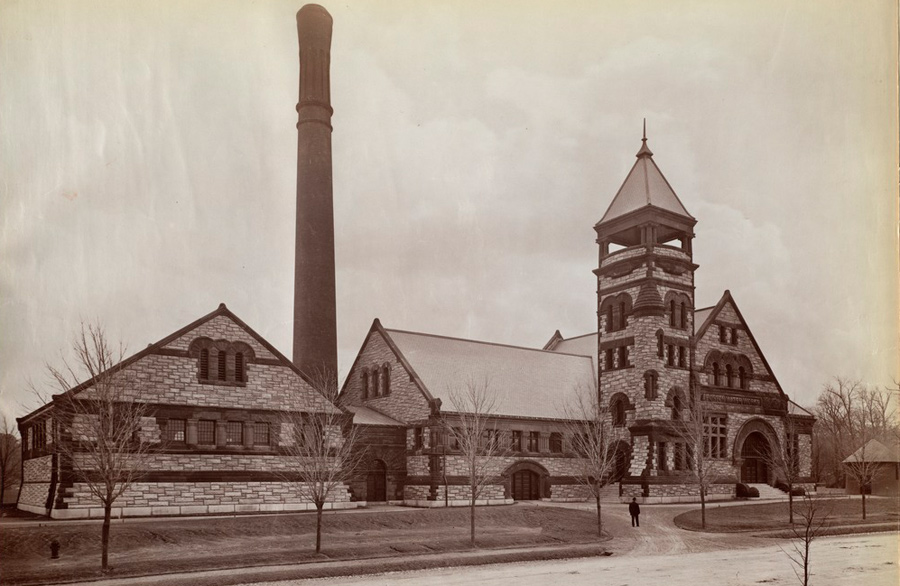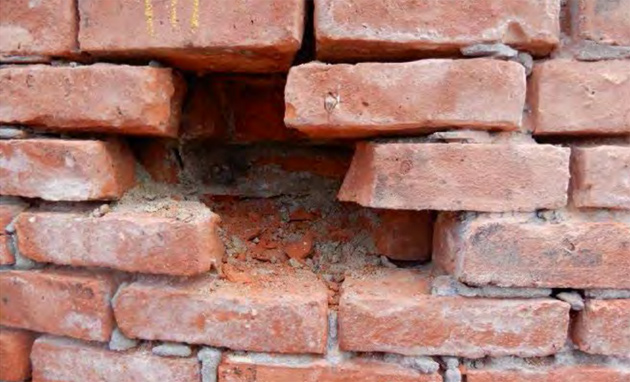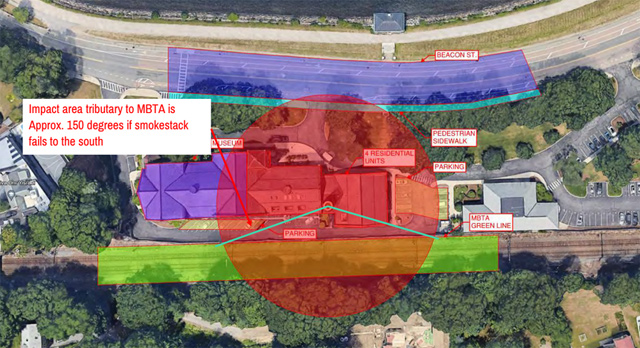
1893 MDC photo of the pumping station, including the smokestack. Source.
The Boston Landmarks Commission agreed yesterday with the owners of one of the 19th-century pumping stations across from the Chestnut Hill Reservoir that its crumbling 150-foot smokestack needs to be taken down before it collapses, either spontaneously or in even a mild earthquake.
But at a hearing on the proposed $742,000 demolition, commission members said they want to see a better way to commemorate its soon to be former presence than reusing some of its bricks for a planter surrounded by bricks in front of the building, the initial proposal by an engineering firm hired by the building's trustees - the owners of four condos in one wing and the Waterworks Museum in the other.
Mike Hughes of SGH, an engineer hired by the building owners, said the unreinforced smokestack has crumbling mortar, cracks and loose bricks and that it has begun to bulge near its base, which is not a good sign. Last year, the building owners had the top swathed in netting to catch any falling bricks.
And while earthquakes in New England are rare, they happen enough that the tower is at risk of collapsing on the Waterworks building and nearby Beacon Street and the Green Line, Hughes said. In fact, he said that over the next ten years, there is a 6.5% to 13.3% chance of a "seismic event" that could topple the smokestack - and he pointed to an April earthquake in New Jersey that could be felt here. A 1755 earthquake off Cape Ann toppled chimneys in Boston - and brought the Faneuil Hall grasshopper to the ground.
Missing bricks and mortar in 2022, and radius of debris field in a collapse, from Epsilon report:


Hughes said trying to retain the smokestack by reinforcing and repairing it, or by surrounding it with a steel lattice, would prove not just expensive but risky in part because the chimney base makes up part of the structure of the Waterworks building - in the residential section - and because any work would require new foundations, which would be difficult to build for the same reason.
"It's just really not possible to do without potentially damaging the existing building," he said.
Instead, Hughes and Doug Kelleher, principal of Epsilon Associates, the principal consulting firm working on the issue, said the only practical solution would be to carefully disassemble the smokestack down to the roof line of the building and then cover that with a new roof.
Commission members quickly agreed the smokestack has to go.
But they voted to set up a sub-committee to meet with engineers on the demolition project on possible ideas for commemorating the smokestack.
One idea would be creating a steel-frame tower to emulate it in place - similar to the steel cap that restored the top of the Haffenreffer smokestack in Jamaica Plain, only way taller.
Another would be figuring out what commission member Jeffrey Heyne called "almost a sundial gnomen," some sort of structure that once a day or maybe once a solstice would cast a shadow similar to the shadow the smokestack now casts.
A third option thrown out by commission members would be just a simple plaque commemorating the smokestack that once towered there, without any sort of brick planter, commission members said.
A planter, even if as wide as the smokestack is now, surrounded by a bench, outside the building, rather than integrated with it, would be "troubling," a memorial, rather than a celebration of the days when the smokestack actually belched smoke from the generator that ran the pumps inside, commission member Bradford Walker said.
Hughes, however, cast doubt on the idea of a steel representation of the smokestack in place, because it would need a steady foundation, which would raise the same issue of how to build that inside a building that is already occupied.
And he said he would be concerned that the steel framing could topple over in a hurricane or could get loaded with ice during winter storms, possibly leading to added weight that could then cause the structure to topple over in a nor'easter.
Heyne added that Hughes' talk of earthquake risk got him worried about buildings in Back Bay, Fort Point and other parts of the city that are built on fill in the event of an earthquake, even solid Trinity Church, which sits on wooden pilings in what was once a bay.
Hughes agreed it's a worrisome thought, but said it's the sheer height of the un-reinforced smokestack that makes it particular vulnerable in a temblor, in contrast to the "substantially stockier" buildings in Boston Proper.
Like the job UHub is doing? Consider a contribution. Thanks!
Ad:
Comments
Go To This Museum
By John Costello
Wed, 05/29/2024 - 8:54am
It's small but for infrastructure buffs, it is great.
Excellent special events
By JoP
Wed, 05/29/2024 - 9:17am
as well, their lecture series are always fascinating.
Waterworks Museum is a gem
By mg
Wed, 05/29/2024 - 10:56am
I seldom agree with John on anything, but he's absolutely correct about this. The Waterworks Museum is lovely.
too bad Fred Dibnah isn't around anymore
By anon
Wed, 05/29/2024 - 9:43am
https://www.bing.com/videos/riverview/relatedvideo...
How about
By Sock_Puppet
Wed, 05/29/2024 - 10:13am
A cellphone tower?
Such BS!
By mg
Wed, 05/29/2024 - 10:55am
This is ridiculous. A plain plaque is ok, but something pretty isn't? And do we really want to celebrate smokestacks belching pollution?
Wait, they can combine both ideas
By BostonDog
Thu, 05/30/2024 - 7:12am
Fill the planter with Black Sollow Wart, Knotweed, and other aggressive, problematic, non-native plants.
Landmarks Commission is obsolete
By Daan
Wed, 05/29/2024 - 12:30pm
They no longer serve Boston. They serve developers and any group that has the money to sway their votes.
The destruction of the former Shreve, Crump and Low building was an obvious case of bending over to developers. What I wonder is what kind of lobbying went on to get the Landmark Commissioners to sacrifice a buetiful building so that it will be replaced by a glass box designed by the firm of Anodyne, Boring and Dullard?
The Home for Little Wanderers was well worth preserving just for its architectural beauty. But again the Commisioners for Destroying Beautiful Buildings were swayed that dull and boring architecture outweighs beauty.
The current Landmarks Commission is as good as what existed prior to the destruction of the original Jordan's Department Store building which was replaced by another structure designed by Anodyne, Boring and Dullard (aka, Macy's at DTX).
Add comment